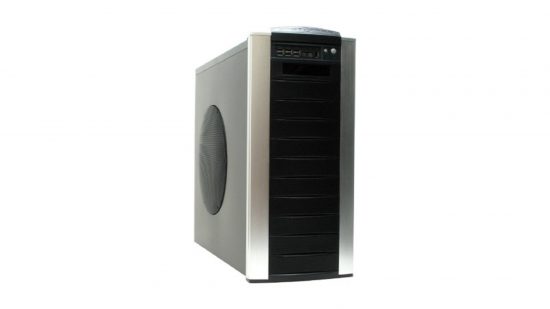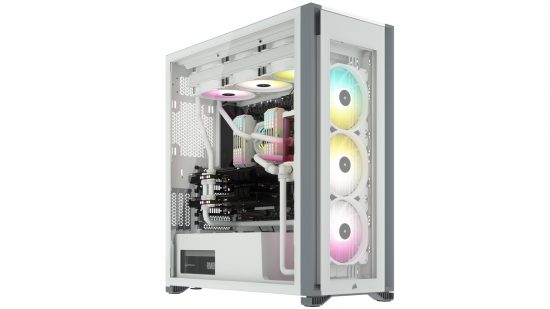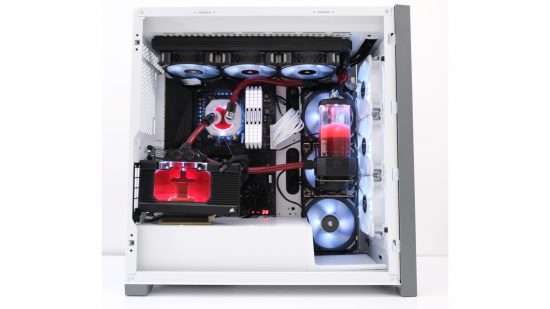When I first got into water cooling, the case features I wanted changed dramatically. I was no longer interested in funky-looking cases. Instead, I wanted plenty of fan mounts, ideally 120mm or larger, and clearance for radiators. Back then, this was difficult to find, as case manufacturers were only just beginning to gear their PCs towards good air cooling, and migrating from 80mm fans to 120mm models.
All-in-one liquid coolers didn’t exist then as we know them today, so case manufacturers admittedly had little reason to factor radiators into their chassis design choices.
As a result, very few cases made decent homes for water-cooled hardware. Cases that did tick all the water-cooling boxes were either extremely expensive due to their size and niche appeal, or not particularly attractive and required modifying.
For instance, one of the first cases I used that could house large radiators was the original Cooler Master Stacker (pictured above). The only reason it was good for water cooling was its massive stack of hard disk bays in the front of the case, hence its name. You could remove these bays, leaving a mesh-fronted chamber that was just wide enough for 120mm radiators, although you had to mount them yourself. There was no space in the roof for a radiator without significant modding, but you could fit a radiator in the base too.
However, even ten years ago, if you bought a mainstream case for around £150, it would probably be limited to housing one radiator, or maybe both a 240mm and 120mm radiator – not enough to handle a high-end, overclocked system without the fans needing to spin up under load. If you wanted to fit a 360mm radiator, your choice was very limited, and if you wanted more radiators than that, so your PC could stay quiet all the time, only a handful of cases could do the job.
Fast forward to 2021 and we have a choice of numerous enormous cases such as the Corsair 7000D Airflow. Corsair now offers several super-sized chassis, and these are the types of cases that used to really excite me when I heard they were inbound. I’d want to know where radiators could be fitted and what size of radiators would fit, as well as whether there were any other water-cooling features. Size was immaterial – you needed to go big if you wanted a high-end water-cooled system.
The situation is very different now though. If you look at any case manufacturer’s line-up, you’ll find much smaller and cheaper cases that can still house plenty of water-cooling gear. Take Corsair’s 5000D Airflow, for example, which can house two 360mm radiators simultaneously.
It costs a little over £100, which is half the price of the larger 7000D Airflow, yet has enough water-cooling capacity to deal with any single-GPU system. We did just this with our recent ultimate water-cooled gaming PC feature, using the RGB-equipped version of the case – the iCUE 5000X RGB, and equipping it with two 360mm radiators to deal with our AMD Ryzen 9 5950X and Nvidia GeForce RTX 3080.
As planned, the system could easily cool our hardware with low fan speeds, with the speeds only rising slightly on warm days in lengthy gaming sessions. It’s cases such as the 5000X that I wish we’d had 15 years ago, especially as they’re just as good at air-cooling your hardware as water-cooling it.
Even if you drop down to micro-ATX and mini-ITX cases, you’ll find far better water-cooling support than most ATX cases had 15 years ago. Most can handle 240mm or 280mm radiators with ease, and some can even handle multiple radiators, especially if you use slim fans and radiators.
For that reason, I switched from monstrous towers that take up half my bedroom or office, to small form factor cases, simply because I don’t need anything bigger. I can house multiple radiators and cool a high-end PC with a single GPU, multiple SSDs and a powerful CPU in a small case now.
I can still appreciate the need for cases such as the 5000D Airflow, though, as there are days when my mini-ITX PC gets toasty and ramps up its fan speeds. It’s also a little trickier to maintain and the water-cooling components I’ve used were specifically picked to fit in this case, so migrating them to another one might not be possible either, unlike with an ATX case.
For me, cases such as the 5000D Airflow offer a perfect balance of air cooling and water cooling, which begs a serious question. Do we need cases to be bigger? The 7000D Airflow is a solid case with support for 420mm and 480mm radiators, but if you have a single GPU, there’s simply no reason to buy it over the 5000D other than willy-waving. It costs more than twice as much money, and that money would be far better put towards a larger SSD or faster graphics card. It’s also hugely heavy and absolutely enormous.
For me, while I hate to admit it, these ultra-large cases just don’t fit into the typical PC gamer ethos anymore. They’re excessively large, have unnecessarily extensive water-cooling potential for single-GPU systems and they cost a fortune too.
I don’t doubt some people will buy them, and some of those people may genuinely need that amount of cooling too. After all, if you have two RTX 3090 cards to cool, or a workstation-focused multi-GPU setup, then you’ll likely need more than a pair of 360mm radiators. This is especially true if you want to work in peace and quiet with a monstrous PC sitting in the same room. That’s a tiny niche in the PC gaming world now though.
This is all good in the end, however, as it means case manufacturers have listened – even sub-£150 cases now have what it takes to deal with high-end hardware, whether it’s cooled with air or water. It’s partly for this reason that we’re seeing so many water-cooled PCs now, as it’s cheaper and easier to do than it was ten years ago.
This is all part of what I love about the PC industry – it keeps bettering itself in most areas as a result of enthusiast feedback – long may that continue.


